
Thursday in the Fire Zone
Sharon and I drove up to Shaver Lake for lunch this Thursday afternoon. We hadn’t been there in at least 20 years, and because our Airbnb is east of Clovis and a mere 35 miles from the lake, we decided — what the heck — let’s make the trip.
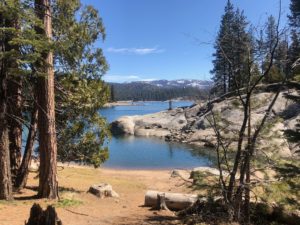 We took home-made chicken sandwiches, sliced apples, chocolate-chip cookies, and a couple of water bottles. The idea was to have a picnic lunch in a lush setting by the lake on a gorgeous spring day.
We took home-made chicken sandwiches, sliced apples, chocolate-chip cookies, and a couple of water bottles. The idea was to have a picnic lunch in a lush setting by the lake on a gorgeous spring day.
And we had all that. It took less than an hour to get there. Any snow from the most recent storm was long-melted — though we could see it on the higher mountains surrounding the lake. The temperature at our 5,500 elevation was a delightful 64 degrees.
We pulled off Highway 168 alongside the lake, walked down a short incline and sat in the shade of a pine tree. In front of us, about a half-dozen families were frolicking in or near the water — and why not? It’s Spring Break around these parts, and what better way to spend it than in one of the Valley’s backyard mountain playgrounds?
Yes, Shaver was as delightful as I remembered it. Unfortunately, in order to get there, we had to drive through much of the mountain area devastated by last year’s Creek Fire. And it was a horrifying sight.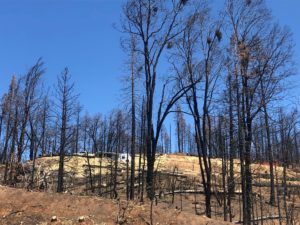
That fire started near Shaver Lake the Friday before last Labor Day. By the time it was 100 percent contained on Christmas Eve, it had burned nearly 380,000 acres and become the fourth-biggest wildfire in modern California history.
It burned more than 850 buildings. Hundreds of people had to be rescued by National Guard helicopters. People were forced out of their homes in Shaver Lake, Bass Lake, Huntington Lake, North Fork, Big Creek, Tollhouse and Auberry. More than 30,000 people in Fresno and Madera counties eventually were evacuated.
Half the homes in Big Creek — which is between Shaver and Huntington lakes — were destroyed. Somehow, firefighters — and Mother Nature — spared the town of Shaver. But the flames burned right up to the dam on the lake, which is north of town.
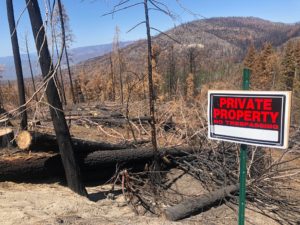 Smoke from that enormous fire generated some of the worst air quality in the nation in the San Joaquin Valley.
Smoke from that enormous fire generated some of the worst air quality in the nation in the San Joaquin Valley.
How could all this happen? Well, let’s start with climate change. Those of us who grew up around these parts know that less rain has been falling here for years — compared to when we were youngsters. The state has been in a long-term drought, alleviated only occasionally by a year of abundant rain — and always followed by more years of rain scarcity.
Millions of trees in the Sierra have died in recent years because there hasn’t been enough rain or snow to keep them alive. Those dead trees acted as extravagant fuel when the fire broke out.
And when that fire erupted — it fast became a firestorm — with NASA confirming that it created one of the biggest pyrocumulonimbus cloud events ever seen in the United States. The fire, in effect, was being fed by these clouds.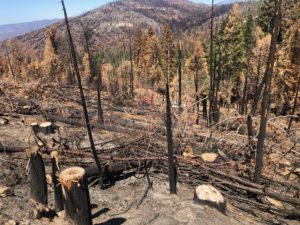
And, of course, there’s always the human “blame game.” Those who live in the forest blame environmentalists for not allowing the tree clearing that’s needed to reduce possible fuel for fires. Environmentalists blame greedy home-owners and land-owners for building in places Mother Nature never intended for construction.
They’re both right.
So after all this, we’re left with a large area utterly devastated — now and for generations. Yes, we can still drive to Shaver for a picnic lunch, but trust me — you can’t get there without driving through areas that eerily look as if you’re on top of the world. No living vegetation.
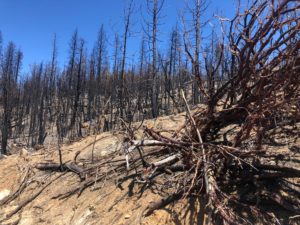 And what’s worse — as you drive through the scorched forest — you know — yes, you know –– that fires like this — and scenes like these — are likely to be a big part of California’s future — and, indeed, the futures of other Western states as well.
And what’s worse — as you drive through the scorched forest — you know — yes, you know –– that fires like this — and scenes like these — are likely to be a big part of California’s future — and, indeed, the futures of other Western states as well.
Because, you see, without rain — and we haven’t had much in years — all it takes is a careless human to drop a match — or Mother Nature to send a lightning bolt — for this to happen over and over.
And in case you’re wondering — the cause of this particular catastrophe is still “under investigation.”
